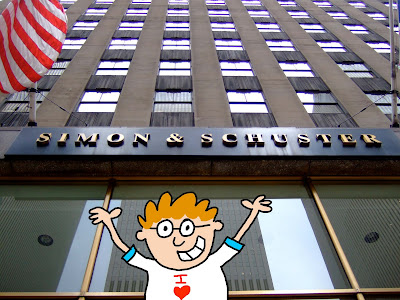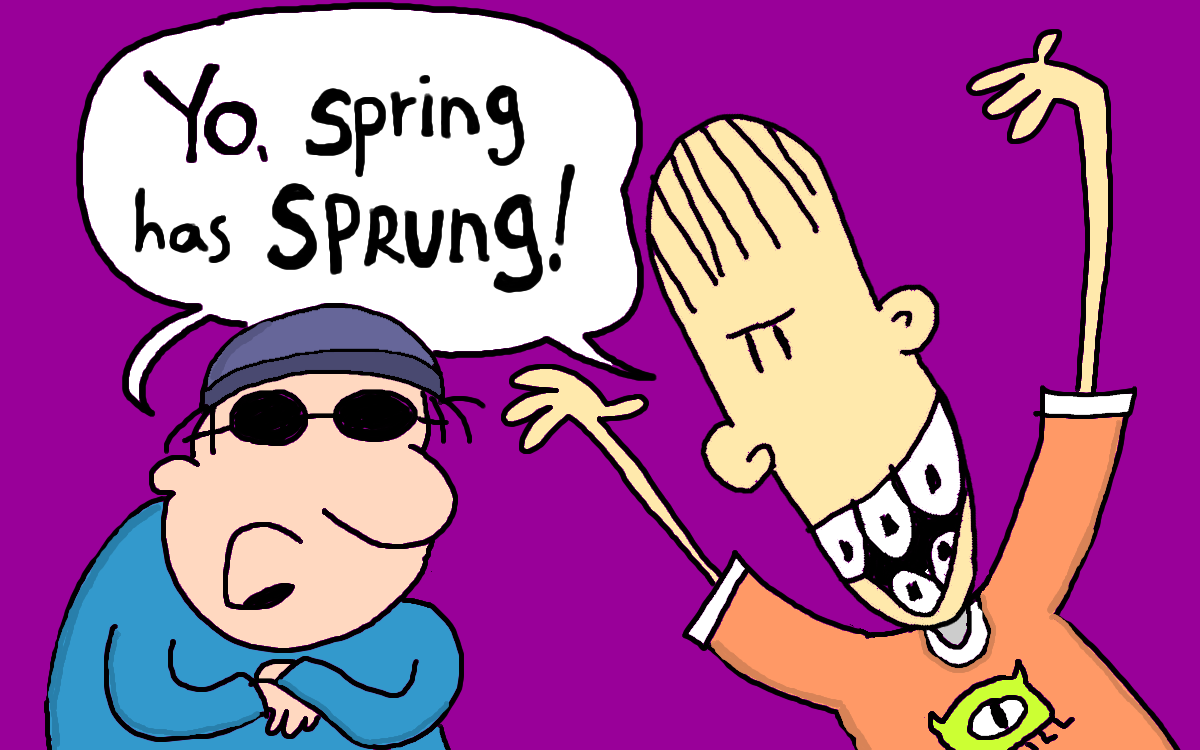 Rachel Renee Russell, the author behind the Dork Diaries series, has signed a deal to write a new middle grade series. Aladdin, an imprint at Simon & Schuster, will release the first installment, entitled The Misadventures of Max Crumbly, in April 2016. Book two will follow in Spring 2017.
Rachel Renee Russell, the author behind the Dork Diaries series, has signed a deal to write a new middle grade series. Aladdin, an imprint at Simon & Schuster, will release the first installment, entitled The Misadventures of Max Crumbly, in April 2016. Book two will follow in Spring 2017.
Publisher Mara Anastas negotiated the deal with Writers House literary agent Daniel Lazar. Associated editorial director Liesa Abrams will edit the manuscripts. Abrams has been working with Russell (pictured, via) since her first Dork Diaries book.
Here’s more from the press release: “The Misadventures of Max Crumbly introduces Max Crumbly and his daily ups and downs at South Ridge Middle School. Homeschooled by his grandmother until he begs his family to send him to public middle school, Max begins to rethink that choice when Tommy Silver keeps stuffing him in his locker. For ages 8-12, this hilarious and heartfelt new series is illustrated with Max’s black-and-white comics as he attempts to escape the locker and tries his best to be the hero his school needs.”
 Scott Westerfeld (pictured, via), Margo Lanagan, and Deborah Biancotti will collaborate on a new young-adult trilogy. The trio of writers have devoted two years to developing the characters and crafting the story for this project.
Scott Westerfeld (pictured, via), Margo Lanagan, and Deborah Biancotti will collaborate on a new young-adult trilogy. The trio of writers have devoted two years to developing the characters and crafting the story for this project.
Simon Pulse will release book one, entitled Zeroes, on September 29th. Publisher Mara Anastas negotiated the deal with Jill Grinberg of the Jill Grinberg Literary Management. Editorial director Liesa Abrams will edit the manuscript.
Here’s more from the press release: “Who are the Zeroes? There’s Ethan, aka Scam, who’s got a voice inside him that’ll say anything you want to hear, whether it’s true or not. There’s Chizara, aka Crash, who can bring technology to its knees; Riley, aka Flicker, who can see through anyone’s eyes but her own; Thibault, aka Anonymous, who’s out of sight, out of mind; Nataniel, aka Bellwether, who can focus any crowd’s energy on a single goal; and Kelsie, who can amp up or damp down a mob’s emotions. They were all born in the year 2000, and live in Cambria, California. Their abilities make them anything but heroes—until a high stakes crisis changes everything.”
Liesa Abrams and
Alan Silberberg teamed up to discuss how authors and editors can best work together. Liesa is executive editor at Aladdin, and Alan is the Sid Fleischman Award-winning author of MILO: STICKY NOTES AND BRAIN FREEZE.
Even before the session started, we could see the deep rapport these two have. No wonder they fired their therapists.
MILO is about a quirky, weird wonderful boy coming to grips with the death of his mother, something Alan related to because he experienced that loss as a child. Initially, he thought the book was going to be funny, but as he delved deeper into his memories, the book got more serious.
"The book has changed my life in so many ways," he said. "My life changed because my agent was able to take this manuscript and hand it over to Liesa."
Liesa related to the book because it was her husband's story, as well. His own mom died of cancer, and he'd spoken about it in similar ways. The closest thing she could come to healing her husband's loss was to work on this book. She really, really wanted to work on it and felt anxiety that it might not come to pass.
"This is the book that will make me feel my entire career has meaning if I can edit this book."
He read from the editorial letter Liesa wrote him, and we all got choked up. "I hadn't just found a way to get Milo published, but I had found this connection with this personal story."
One challenge was to separate themselves from the story a bit. Alan, who illustrated MILO, experimented with characters that looked less like him. Being able to have Liesa put a little distance between himself and the material allowed him to edit it from a safer place.
"I don't mean to get all therapy on you," he said, "but I really needed to feel safe to go back into these memories."
Liesa gave an example of how they shaped the story: the Milo character wrote about headaches making him think of drafting a will. It's not a kid point of view to think that way, so he wrote that Milo felt scared instead.
Liesa never asked which scenes were autobiographical (they were all emotionally true, but some were fictionalized). She was glad to have that distance, which let her look at it as a work of fiction.
"The reader only knows what's there on the page. They're reading that book. You're not there. It's not that actions can't be contradictory--you have to understand why the character is contradicting themselves."
"It's not just about the advance and the royalties," Liesa said. "It makes a world of difference to have a relationship like this... the writing is the most personal thing you can do."
Alan and Liesa made us all cry when they talked about the healing this book had brought about. “Not every editor relationship requires tissues, you know.”
 |
| Liesa Abrams |
Liesa Abrams is executive editor at Aladdin, an imprint of Simon & Schuster. (She also owns 40 Batman T-shirts and apparently had a Batman-themed wedding, which sounds too awesome to believe, even if it didn't get crashed by the Joker.) Her books include DORK DIARIES, BEYONDERS: A WORLD WITHOUT HEROES, and the PENDRAGON series.
She led a Friday-morning breakout session on the sweet spot of middle grade fiction: commercial books, and started off by talking a bit about Aladdin, her imprint, which publishes picture book through middle grade, with a special focus on MG titles.
Middle grade is hot, she says. YA gets lots of attention, but many of the big properties of late have been middle grade: Percy Jackson, Diary of a Wimpy Kid, Eragon, Harry Potter.
As a perpetual 12-year-old boy, she finds middle grade to be an exciting age to write and edit for. She still vividly remembers lying on the couch reading THE LION, THE WITCH, AND THE WARDROBE for the first time. "I don’t thinkreading has ever been the same as it was back then," she says.
She offered a few helpful definitions and things to shoot for. First, middle grade covers a wide spectrum. It's often defined as books for readers ages 8-12. So you have to think about whether you're shooting for the younger or the older end of the spectrum. Generally, your characters shouldn't be older than 12 or 13--but your story isn't necessarily MG just because your characters are that age.
Another key consideration is to make the various components of the book relatable to kids in the middle-grade market. The plot, the theme, the voice ... they all have to resonate. Middle-grade readers have a different world perspective than a YA audience. A middle-grader wants to know how they fit into the world. A YA reader wants to know what sets them apart.
She also talked about the importance of hook. It's no less vital in a MG book, despite the perception to the contrary. A hook isn't plot. It isn't theme. It's not necessarily fantasy or supernatural. It's the thing that sets your book apart. It must be easily summarized. It can sometimes be a format thing (a book in diary or text-message format, or a mix of text and art.
You have to be careful with sex and language in middle grades (moreso than with YA). If there is any--even though those things are part of the lives of younger kids--parents will complain about it. The shorthand for this stuff is "content," and Liesa got a huge laugh when she said she had to reassure her marketing department by saying "this is a book with no content."

By: Maryann Yin,
on 6/24/2011
Blog:
Galley Cat (Mediabistro)
(
Login to Add to MyJacketFlap)
JacketFlap tags:
Writers House,
Liesa Abrams,
Rachel Renee Russell,
Dork Diaries,
Daniel Lazar,
dorks rule,
Mara Anastas,
Nikki Maxwell,
Snoopy happy dance,
middle grade,
Add a tag
 Author Rachel Renee Russell has inked a deal with Simon & Schuster’s Aladdin imprint to publish books five and six (currently untitled) in the popular Dork Diaries middle grade series.
Author Rachel Renee Russell has inked a deal with Simon & Schuster’s Aladdin imprint to publish books five and six (currently untitled) in the popular Dork Diaries middle grade series.
Aladdin will release the fourth title, Dork Diaries 3 ½: How to Dork Your Diary, in October. Book five will follow in fall 2012 and book six is coming in spring 2013. Publisher Mara Anastas negotiated the deal with Writers House literary agent Daniel Lazar. Executive editor Liesa Abrams will serve as editor for all the forthcoming books.
Russell had this statement in the release: “As my character Nikki Maxwell might say, Squee! Or she might break into a Snoopy happy dance. That’s how excited I am to be writing and drawing more Dork Diaries books. Watching this series grow and be embraced by fans all over the world has been a dream come true, and I’m so happy that I can keep showing my readers that, indeed, dorks rule!”
New Career Opportunities Daily: The best jobs in media.

By: James Preller,
on 2/24/2011
Blog:
James Preller's Blog
(
Login to Add to MyJacketFlap)
JacketFlap tags:
Donna Bray,
Betsy Bird,
Six Innings,
Kurtis Scaletta,
Matthew Cordell,
Liesa Abrams,
Half Magic,
Carmen Deedy,
100 Scope Notes,
Travis Jonker,
Interviews & Appreciations,
cancer children's books,
Albert Brooks Broadcast news,
Bill Prosser,
death of a mother,
Literate Lives,
pickel is funny,
Pond Scum Silberberg,
Show don't tell lesson,
Six Innings Preller,
Sue Townsend,
The sunshine boys,
TV Guide appreciation,
Add a tag
If you missed Part One of the Alan Silberberg Interview, it’s absurd for you to be here. I mean, really. Please follow the link to catch up.
Don’t worry, we’ll wait . . .

Late in the book, Milo gathers together a number of objects that remind him of his mother, that press the memory of her into his consciousness. Where’d you get the idea for that?
I think that comes from the fact that I really don’t have anything from my mother. Things did get thrown away or given away and it really was like she died and then she was erased. When I was writing the book I started to think hard about my mom and tried remembering objects that evoked her to me. That became a cartoon called “Memories Lost” which were all real objects from my childhood that connected me to her. After making that cartoon, it struck me that Milo would want to go out and replace those objects somehow and that’s why he and his friends hit up the yard sales.

There is a scene toward the end in one of my books, Six Innings (a book that similarly includes a biographical element of cancer), that I can’t read aloud to a group because I know I’ll start to slobber. It’s just too raw, too personal for me. And I suspect that might be true of you with certain parts of this book. I’m asking: Are there any moments that get to you every time?
I think there are two specific parts of the book that choke me up, though lots of little places make me reach for tissues. The chapter where Milo goes to the yard sale and finds a blanket that reminds him of the one his mom had will always get to me. My mom had that blanket, the “pea patch blanket” in the book — so as Milo wraps himself in it and remembers her getting sick — I am always transported to the image of my mom and her blanket. The second place in the book happens in cartoon form, when Milo remembers the last time he saw his mother, which was when she was already under anesthesia being prepped for surgery and she has had her head shaved and he can see the lines for the surgery drawn on her head like a tic tac toe board. That image is directly from my memory of my last time seeing my mother. It’s pretty heavy stuff.

And so powerfully authentic. Milo describes that period after his mother died as “the fog.” Was that your memory of it?
I think trauma at any age creates a disconnect inside us. I think the fog settled in for me slowly. As the initial shock of my
I have always marveled at the people who can point easily to the perfect days in their lives and say without pause, "That was the best day." I mean, I'm a writer. Ask me to point to a miserable day and I can deal out a dozen or so in a heartbeat.
But the game has changed because I now have that day, that PERFECT DAY, etched forever in my brain-box. It all began with a weekend trip to New York to visit with my editor, Liesa Abrams, at Aladdin. Apparently there were people in her office who had read MILO: STICKY NOTES & BRAIN FREEZE and wanted a chance to meet me. Cool, I thought. I'll just drive down from Montreal and take Milo with me on the one condition that I control the radio.
The weekend fun was kicked off by walking from our hotel through Times Square on our way to meet Liesa and her husband for a matinee of AVENUE Q. Times Square always smells like a hot summer day so it felt normal to be bombarded by the sights, sounds and smells of a 92 degree, humid summer Sunday.
 After Milo and I sweated through clean shirts and baked under the July haze - we got to the theater and sat through the hysterical musical. Everyone says the puppets are "so racy" - but even Milo thought the show was kind of tame. I guess that's what watching so much SOUTH PARK will do to a kid's brain!
After Milo and I sweated through clean shirts and baked under the July haze - we got to the theater and sat through the hysterical musical. Everyone says the puppets are "so racy" - but even Milo thought the show was kind of tame. I guess that's what watching so much SOUTH PARK will do to a kid's brain!
 Rachel Renee Russell, the author behind the Dork Diaries series, has signed a deal to write a new middle grade series. Aladdin, an imprint at Simon & Schuster, will release the first installment, entitled The Misadventures of Max Crumbly, in April 2016. Book two will follow in Spring 2017.
Rachel Renee Russell, the author behind the Dork Diaries series, has signed a deal to write a new middle grade series. Aladdin, an imprint at Simon & Schuster, will release the first installment, entitled The Misadventures of Max Crumbly, in April 2016. Book two will follow in Spring 2017.






 Author Rachel Renee Russell has inked a deal with Simon & Schuster’s Aladdin imprint to publish books five and six (currently untitled) in the popular Dork Diaries middle grade series.
Author Rachel Renee Russell has inked a deal with Simon & Schuster’s Aladdin imprint to publish books five and six (currently untitled) in the popular Dork Diaries middle grade series.






Awesome info! Thanks so much for posting all this!